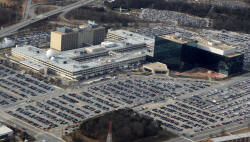Distrustful U.S. allies force spy agency to back down in
encryption fight
 Send a link to a friend
Send a link to a friend
 [September 21, 2017]
By Joseph Menn [September 21, 2017]
By Joseph Menn
SAN FRANCISCO (Reuters) - An international
group of cryptography experts has forced the U.S. National Security
Agency to back down over two data encryption techniques it wanted set as
global industry standards, reflecting deep mistrust among close U.S.
allies.
In interviews and emails seen by Reuters, academic and industry experts
from countries including Germany, Japan and Israel worried that the U.S.
electronic spy agency was pushing the new techniques not because they
were good encryption tools, but because it knew how to break them.
The NSA has now agreed to drop all but the most powerful versions of the
techniques - those least likely to be vulnerable to hacks - to address
the concerns.
The dispute, which has played out in a series of closed-door meetings
around the world over the past three years and has not been previously
reported, turns on whether the International Organization of Standards
should approve two NSA data encryption techniques, known as Simon and
Speck.

The U.S. delegation to the ISO on encryption issues includes a handful
of NSA officials, though it is controlled by an American standards body,
the American National Standards Institute (ANSI).
The presence of the NSA officials and former NSA contractor Edward
Snowden's revelations about the agency's penetration of global
electronic systems have made a number of delegates suspicious of the
U.S. delegation's motives, according to interviews with a dozen current
and former delegates.
A number of them voiced their distrust in emails to one another, seen by
Reuters, and in written comments that are part of the process. The
suspicions stem largely from internal NSA documents disclosed by Snowden
that showed the agency had previously plotted to manipulate standards
and promote technology it could penetrate. Budget documents, for
example, sought funding to “insert vulnerabilities into commercial
encryption systems.”
More than a dozen of the experts involved in the approval process for
Simon and Speck feared that if the NSA was able to crack the encryption
techniques, it would gain a "back door" into coded transmissions,
according to the interviews and emails and other documents seen by
Reuters.
“I don’t trust the designers,” Israeli delegate Orr Dunkelman, a
computer science professor at the University of Haifa, told Reuters,
citing Snowden's papers. “There are quite a lot of people in NSA who
think their job is to subvert standards. My job is to secure standards.”
The NSA, which does not confirm the authenticity of any Snowden
documents, told Reuters it developed the new encryption tools to protect
sensitive U.S. government computer and communications equipment without
requiring a lot of computer processing power.
NSA officials said via email they want commercial technology companies
that sell to the government to use the techniques, and that is more
likely to happen when they have been designated a global standard by the
ISO.

Asked if it could beat Simon and Speck encryption, the NSA officials
said: "We firmly believe they are secure."
THE CASE OF THE DUAL ELLIPTIC CURVE
ISO, an independent organization with delegations from 162 member
countries, sets standards on everything from medical packaging to road
signs. Its working groups can spend years picking best practices and
technologies for an ISO seal of approval.
As the fight over Simon and Speck played out, the ISO twice voted to
delay the multi-stage process of approving them.
In oral and written comments, opponents cited the lack of peer-reviewed
publication by the creators, the absence of industry adoption or a clear
need for the new ciphers, and the partial success of academics in
showing their weaknesses.
Some ISO delegates said much of their skepticism stemmed from the 2000s,
when NSA experts invented a component for encryption called Dual
Elliptic Curve and got it adopted as a global standard.
[to top of second column] |

An aerial view shows the
National Security Agency (NSA) headquarters in Ft. Meade, Maryland,
U.S. on January 29, 2010. REUTERS/Larry Downing/File Photo

ISO's approval of Dual EC was considered a success inside the agency, according
to documents passed by Snowden to the founders of the online news site The
Intercept, which made them available to Reuters. The documents said the agency
guided the Dual EC proposal through four ISO meetings until it emerged as a
standard.
In 2007, mathematicians in private industry showed that Dual EC could hide a
back door, theoretically enabling the NSA to eavesdrop without detection. After
the Snowden leaks, Reuters reported that the U.S. government had paid security
company RSA $10 million to include Dual EC in a software development kit that
was used by programmers around the world.
The ISO and other standards groups subsequently retracted their endorsements of
Dual EC. The NSA declined to discuss it.
In the case of Simon and Speck, the NSA says the formulas are needed for
defensive purposes. But the official who led the now-disbanded NSA division
responsible for defense, known as the Information Assurance Directorate, said
his unit did not develop Simon and Speck.
"There are probably some legitimate questions around whether these ciphers are
actually needed," said Curtis Dukes, who retired earlier this year. Similar
encryption techniques already exist, and the need for new ones is theoretical,
he said.
ANSI, the body that leads the U.S. delegation to the ISO, said it had simply
forwarded the NSA proposals to the organization and had not endorsed them.
FROM JAIPUR TO HAMILTON
When the United States first introduced Simon and Speck as a proposed ISO
standard in 2014, experts from several countries expressed reservations, said
Shin’ichiro Matsuo, the head of the Japanese encryption delegation.

Some delegates had no objection. Chris Mitchell, a member of the British
delegation, said he supported Simon and Speck, noting that "no one has succeeded
in breaking the algorithms." He acknowledged, though, that after the Dual EC
revelations, "trust, particularly for U.S. government participants in
standardization, is now non-existent."
At a meeting in Jaipur, India, in October 2015, NSA officials in the American
delegation pushed back against critics, questioning their expertise, witnesses
said.
A German delegate at the Jaipur talks, Christian Wenzel-Benner, subsequently
sent an email seeking support from dozens of cryptographers. He wrote that all
seven German experts were “very concerned” about Simon and Speck.
“How can we expect companies and citizens to use security algorithms from ISO
standards if those algorithms come from a source that has compromised
security-related ISO standards just a few years ago?” Wenzel-Benner asked.
Such views helped delay Simon and Speck again, delegates said. But the Americans
kept pushing, and at an October 2016 meeting in Abu Dhabi, a majority of
individual delegates approved the techniques, moving them up to a
country-by-country vote.
There, the proposal fell one vote short of the required two-thirds majority.
Finally, at a March 2017 meeting in Hamilton, New Zealand, the Americans
distributed a 22-page explanation of its design and a summary of attempts to
break them - the sort of paper that formed part of what delegates had been
seeking since 2014.
Simon and Speck, aimed respectively at hardware and software, each have robust
versions and more "lightweight" variants. The Americans agreed in Hamilton to
compromise and dropped the most lightweight versions.
Opponents saw that as a major if partial victory, and it paved the way to
compromise. In another nation-by-nation poll last month, the sturdiest versions
advanced to the final stage of the approval process, again by a single vote,
with Japan, Germany and Israel remaining opposed. A final vote takes place in
February.
(Reporting by Joseph Menn; Editing by Jonathan Weber and Ross Colvin)
[© 2017 Thomson Reuters. All rights
reserved.] Copyright 2017 Reuters. All rights reserved. This material may not be published,
broadcast, rewritten or redistributed. |